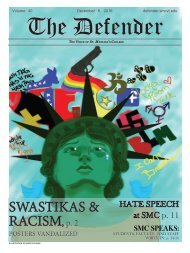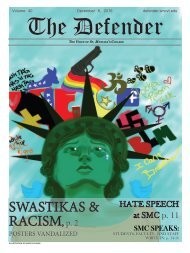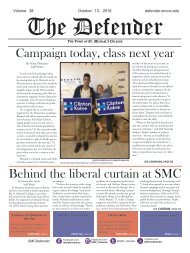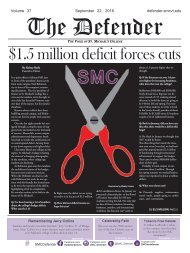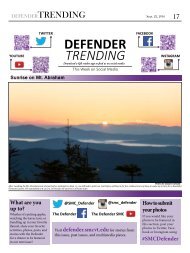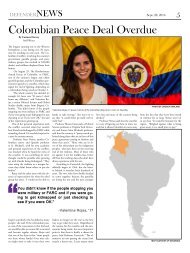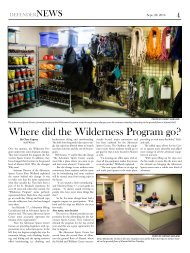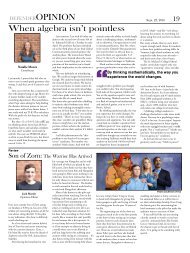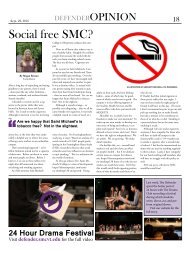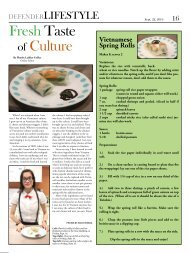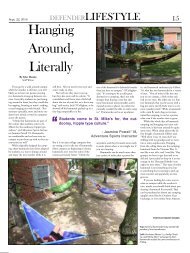FALL ISSUE 4-December 8,2016
Create successful ePaper yourself
Turn your PDF publications into a flip-book with our unique Google optimized e-Paper software.
defenderPOLITICS Dec. 8, <strong>2016</strong> 11<br />
Hate speech and SMC:<br />
First Amendment expert sheds light<br />
By Lance Reynolds<br />
Staff Writer<br />
Traci Griffith has a passion for law,<br />
especially when it comes to speech. So it<br />
comes as no surprise that Griffith, chair<br />
of the media studies, journalism, and<br />
digital arts department, says Media Law<br />
and Ethics is one of her favorite courses<br />
to teach St. Michael’s College students.<br />
In fact, she is often one of the first sources<br />
that local media will call when a case<br />
involving the First Amendment is under<br />
scrutiny.<br />
As the VP representitive on the<br />
board of directors of the American Civil<br />
Liberties Union, Griffith, a graduate of<br />
Notre Dame Law School, reviews legal<br />
cases that involve<br />
civil rights conflicts.<br />
In a time of political<br />
change, with hateful<br />
rhetoric and historically<br />
loaded symbols<br />
making their way to<br />
the mainstream, Griffith<br />
sat down with The<br />
Defender to discuss<br />
recent events on campus, the differences<br />
between free speech and hate speech, and<br />
how the conflict between the two will<br />
always remain.<br />
Q: Recently posters have been<br />
defaced here on campus. One of them,<br />
promoting an event for migrant justice,<br />
had swastikas and “Trump <strong>2016</strong>”<br />
drawn on it, and the other had “Make<br />
ILLUSTRATION BY MARIE SALINAS<br />
America White Again” written on it.<br />
What do you make of this case?<br />
A: The real question is, what kind<br />
of community do we want to be? If we<br />
decide that we aren’t going to allow that<br />
kind of thing, we can do that. How do<br />
the people who are being targeted feel<br />
about it, and how as a community are we<br />
willing to allow members of our society<br />
to be targeted in that way?<br />
Q: Can you explain what would<br />
be disallowed if the incidents were<br />
considered hate speech?<br />
A: I think it gets to the core of who<br />
we are as a community. I can’t define<br />
that. The campus has to define that. If<br />
we want to say that free speech is allowed<br />
regardless of who it targets, who it makes<br />
to feel unwelcomed within our community,<br />
then we are a very different kind of<br />
community. If we say our community is<br />
based on Christian faith and acceptance<br />
and love of all human beings, then that<br />
seems very contradictory to a swastika<br />
message. It really is about how we<br />
define ourselves as a community, who is<br />
welcomed in our<br />
community, and<br />
who we are choosing<br />
to exclude<br />
from our community.<br />
Are we<br />
willing to support<br />
those who were<br />
targeted and say<br />
you are welcomed<br />
here, you belong<br />
here? Those members<br />
who seek to<br />
spew hate at you,<br />
they are the ones<br />
who should not be<br />
members of our<br />
community, or<br />
should somehow<br />
be educated as to<br />
what our community<br />
stands for.<br />
Q: For someone who has never<br />
been taught about the topic, how<br />
would you outline free speech and hate<br />
speech?<br />
A: Hate speech crosses the line of<br />
free speech when it targets a particular<br />
individual or a group of individuals<br />
based on certain protected classes; race,<br />
gender, ethnicity, national origin, etc.<br />
If people are targeted based on those<br />
specific things, it can rise to the level of<br />
hate speech.<br />
Q: Do you believe this case is a<br />
form of hate speech?<br />
A: The use of swastikas is clearly<br />
Hateful ideas often lead to hateful actions. Members of our community<br />
are facing hateful actions every day. We call ourselves a<br />
welcoming community, but are we really?”<br />
-Traci Griffith,<br />
Media Studies, Journalism, & Digital Arts Department Chair<br />
hate speech. It’s specifically targeted to<br />
particular groups of people. Swastikas<br />
represent something very specific. It’s not<br />
just a symbol, it’s the message behind<br />
the symbol. It’s a symbol that represents<br />
a period of history in which particular<br />
groups of people were targeted for death.<br />
In this case, the symbol was targeted towards<br />
migrant justice – which represents<br />
migrant farm workers who are largely<br />
Hispanic.<br />
Q: It is hard, or nearly impossible,<br />
to remove your own self and identity<br />
from your work and what you hear in<br />
the news. As a woman of color, how<br />
does the mainstreaming of hateful<br />
speech make you feel?<br />
A: I am not surprised at all by the<br />
hateful rhetoric that has followed this<br />
election. It was a main part of the election<br />
and quite honestly has been a main<br />
part of our society since its inception. In<br />
recent years polite society has squashed<br />
the hateful speech but the emotions that<br />
fuel the hatred have not been addressed<br />
and therefore never really went away.<br />
Racism is alive and well in our country.<br />
Hate speech is just an expression of that.<br />
Q. With the controversial political<br />
election and our own campus seeing<br />
vandalism, how important is the law<br />
around free speech right now?<br />
A: The First Amendment becomes<br />
even more important during times of<br />
conflict, during times of dissent because<br />
the aim of the First Amendment is to<br />
protect the rights of those who have unpopular<br />
views. It really is about making<br />
sure that those who are often descending<br />
or speaking out against a popular view<br />
speaking out against the government<br />
have the ability to do that.<br />
Q: What counts as speech and<br />
what exactly is it considered to be?<br />
A: Recently, we heard from the<br />
president-elect the notion of if you burn<br />
a flag that you might lose your citizenship<br />
or you should<br />
be locked up. The<br />
Supreme Court has<br />
said just the opposite;<br />
flag burning is<br />
a form of expression.<br />
If the idea<br />
behind it is that<br />
there is some intent<br />
to express an idea,<br />
then that’s protected speech.<br />
Q: What are the differences between<br />
“offensive” speech and “criminal”<br />
speech? Where is the line drawn<br />
between the two?<br />
A: Everyone is going to be offended<br />
by something. It’s not about someone<br />
being offended, it’s about someone being<br />
threatened and targeted. It’s about a specific<br />
message that is a negative message<br />
towards a particular group of people. The<br />
use of the swastika sends that message,<br />
and it has almost transcended its original<br />
message of hatred towards Jews. It’s a<br />
universal symbol of hate for all kinds of<br />
minority groups – in this circumstance,<br />
Hispanic migrants, but it is just as easily<br />
could have been aimed at Blacks, homosexuals,<br />
etc.<br />
Q: What are some consequences<br />
you fear of these hateful ideas becoming<br />
mainstream?<br />
A: Hateful ideas often lead to hateful<br />
actions. Members of our community are<br />
facing hateful actions every day. Students<br />
are being threatened and intimidated,<br />
ridiculed in class and made to feel as if<br />
they don’t belong here. We call ourselves<br />
a welcoming community, but are we<br />
really?



